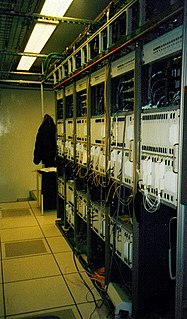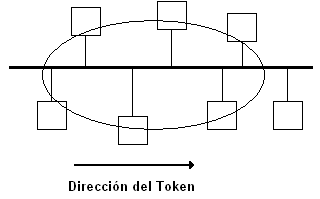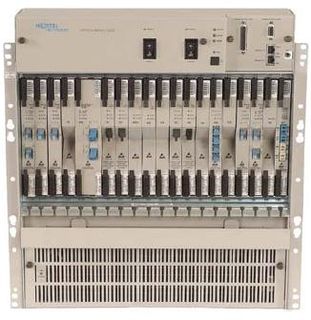
Ethernet is a family of wired computer networking technologies commonly used in local area networks (LAN), metropolitan area networks (MAN) and wide area networks (WAN). It was commercially introduced in 1980 and first standardized in 1983 as IEEE 802.3. Ethernet has since been refined to support higher bit rates, a greater number of nodes, and longer link distances, but retains much backward compatibility. Over time, Ethernet has largely replaced competing wired LAN technologies such as Token Ring, FDDI and ARCNET.

Synchronous optical networking (SONET) and synchronous digital hierarchy (SDH) are standardized protocols that transfer multiple digital bit streams synchronously over optical fiber using lasers or highly coherent light from light-emitting diodes (LEDs). At low transmission rates data can also be transferred via an electrical interface. The method was developed to replace the plesiochronous digital hierarchy (PDH) system for transporting large amounts of telephone calls and data traffic over the same fiber without the problems of synchronization.
A network switch is networking hardware that connects devices on a computer network by using packet switching to receive and forward data to the destination device.

Network topology is the arrangement of the elements of a communication network. Network topology can be used to define or describe the arrangement of various types of telecommunication networks, including command and control radio networks, industrial fieldbusses and computer networks.
The Spanning Tree Protocol (STP) is a network protocol that builds a loop-free logical topology for Ethernet networks. The basic function of STP is to prevent bridge loops and the broadcast radiation that results from them. Spanning tree also allows a network design to include backup links providing fault tolerance if an active link fails.
A virtual LAN (VLAN) is any broadcast domain that is partitioned and isolated in a computer network at the data link layer. LAN is the abbreviation for local area network and in this context virtual refers to a physical object recreated and altered by additional logic. VLANs work by applying tags to network frames and handling these tags in networking systems – creating the appearance and functionality of network traffic that is physically on a single network but acts as if it is split between separate networks. In this way, VLANs can keep network applications separate despite being connected to the same physical network, and without requiring multiple sets of cabling and networking devices to be deployed.

Token bus is a network implementing a Token Ring protocol over a virtual ring on a coaxial cable. A token is passed around the network nodes and only the node possessing the token may transmit. If a node doesn't have anything to send, the token is passed on to the next node on the virtual ring. Each node must know the address of its neighbour in the ring, so a special protocol is needed to notify the other nodes of connections to, and disconnections from, the ring.

A ring network is a network topology in which each node connects to exactly two other nodes, forming a single continuous pathway for signals through each node – a ring. Data travels from node to node, with each node along the way handling every packet.
Packet over SONET/SDH, abbreviated POS, is a communications protocol for transmitting packets in the form of the Point to Point Protocol (PPP) over SDH or SONET, which are both standard protocols for communicating digital information using lasers or light emitting diodes (LEDs) over optical fibre at high line rates. POS is defined by RFC 2615 as PPP over SONET/SDH. PPP is the Point to Point Protocol that was designed as a standard method of communicating over point-to-point links. Since SONET/SDH uses point-to-point circuits, PPP is well suited for use over these links. Scrambling is performed during insertion of the PPP packets into the SONET/SDH frame to solve various security attacks including denial-of-service attacks and the imitation of SONET/SDH alarms. This modification was justified as cost-effective because the scrambling algorithm was already used by the standard used to transport ATM cells over SONET/SDH. However, scrambling can optionally be disabled to allow a node to be compatible with another node that uses the now obsoleted RFC 1619 version of Packet over SONET/SDH which lacks the scrambler.
Spatial Reuse Protocol is a networking protocol developed by Cisco. It is a MAC-layer protocol for ring-based packet internetworking that is commonly used in optical fiber ring networks. Ideas from the protocol are reflected in parts of the IEEE 802.17 Resilient Packet Ring (RPR) standard.

In computer networking, link aggregation is the combining of multiple network connections in parallel by any of several methods, in order to increase throughput beyond what a single connection could sustain, to provide redundancy in case one of the links should fail, or both. A link aggregation group (LAG) is the combined collection of physical ports.

A metropolitan-area Ethernet, Ethernet MAN, or metro Ethernet network is a metropolitan area network (MAN) that is based on Ethernet standards. It is commonly used to connect subscribers to a larger service network or the Internet. Businesses can also use metropolitan-area Ethernet to connect their own offices to each other.

A computer network is a set of computers sharing resources located on or provided by network nodes. The computers use common communication protocols over digital interconnections to communicate with each other. These interconnections are made up of telecommunication network technologies, based on physically wired, optical, and wireless radio-frequency methods that may be arranged in a variety of network topologies.
Dynamic Packet Transport (DPT) is a Cisco transport protocol designed for use in optical fiber ring networks. In overview, it is quite similar to POS and DTM. It was one of the major influences on the Resilient Packet Ring/802.17 standard.
Provider Backbone Bridge Traffic Engineering (PBB-TE) is an approved telecommunications networking standard, IEEE 802.1Qay-2009. PBB-TE adapts Ethernet technology to carrier class transport networks. It is based on the layered VLAN tags and MAC-in-MAC encapsulation defined in IEEE 802.1ah, but it differs from PBB in eliminating flooding, dynamically created forwarding tables, and spanning tree protocols. Compared to PBB and its predecessors, PBB-TE behaves more predictably and its behavior can be more easily controlled by the network operator, at the expense of requiring up-front connection configuration at each bridge along a forwarding path. PBB-TE Operations, Administration, and Management (OAM) is usually based on IEEE 802.1ag. It was initially based on Nortel's Provider Backbone Transport (PBT).
Data center bridging (DCB) is a set of enhancements to the Ethernet local area network communication protocol for use in data center environments, in particular for use with clustering and storage area networks.
High-availability Seamless Redundancy (HSR) is a network protocol for Ethernet that provides seamless failover against failure of any single network component. PRP and HSR are independent of the application-protocol and can be used by most Industrial Ethernet protocols in the IEC 61784 suite. HSR does not cover the failure of end nodes, but redundant nodes can be connected via HSR.
Time-Sensitive Networking (TSN) is a set of standards under development by the Time-Sensitive Networking task group of the IEEE 802.1 working group. The TSN task group was formed in November 2012 by renaming the existing Audio Video Bridging Task Group and continuing its work. The name changed as a result of the extension of the working area of the standardization group. The standards define mechanisms for the time-sensitive transmission of data over deterministic Ethernet networks.
Deterministic Networking (DetNet) is an effort by the IETF DetNet Working Group to study implementation of deterministic data paths for real-time applications with extremely low data loss rates, packet delay variation (jitter), and bounded latency, such as audio and video streaming, industrial automation, and vehicle control.

Audio Video Bridging (AVB) is a common name for the set of technical standards which provide improved synchronization, low-latency, and reliability for switched Ethernet networks. AVB embodies the following technologies and standards:






